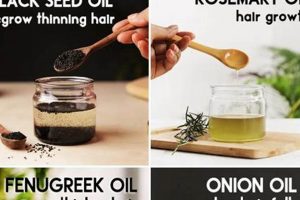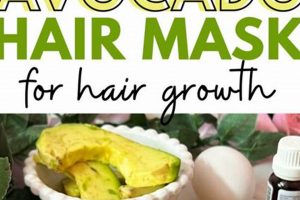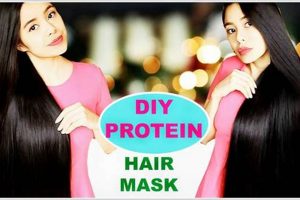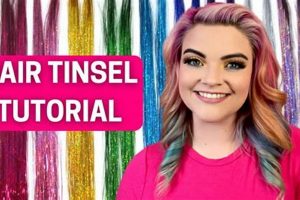Creating shimmering, decorative accents for one’s hairstyle at home involves combining cosmetic-grade glitter with various binding agents. A common example includes mixing fine iridescent particles with hair gel to produce a temporary, festive embellishment.
This process offers cost-effectiveness and customization options, allowing individuals to achieve unique looks tailored to specific events or personal preferences. Historically, adornment of hair with reflective materials can be traced to various cultures, reflecting a desire for aesthetic enhancement and self-expression.
The following sections will detail the necessary materials, safe application methods, and removal techniques for producing these homemade shimmering hair enhancements.
DIY Hair Glitter
Achieving a successful and safe application requires attention to detail and adherence to best practices. The following tips ensure optimal results while minimizing potential risks.
Tip 1: Select Cosmetic-Grade Glitter. Employing craft glitter is discouraged due to its potential for abrasiveness and irritation to the scalp and eyes. Cosmetic-grade variations are specifically manufactured with rounded edges and non-toxic materials, ensuring safety for topical application.
Tip 2: Choose a Suitable Binding Agent. Hair gel, hair wax, or hairspray can effectively secure the glitter to the hair shaft. Opt for products that offer strong hold without excessive stickiness, which can complicate removal. Conduct a patch test to assess compatibility with the binding agent.
Tip 3: Control Application Volume. Applying glitter sparingly prevents clumping and allows for even distribution. Start with a small amount and gradually add more to achieve the desired intensity. Avoid applying too close to the scalp to minimize potential irritation.
Tip 4: Employ Precise Application Techniques. Use a small brush, applicator wand, or even fingertips to strategically place the glitter. Sectioning the hair and applying glitter in layers ensures a uniform and professional-looking finish.
Tip 5: Prioritize Gentle Removal. Avoid pulling or tugging at the hair during removal. Thoroughly rinse the hair with lukewarm water to loosen the glitter. Follow with a moisturizing shampoo and conditioner to replenish lost moisture.
Tip 6: Prevent Environmental Contamination. When rinsing, use a fine-mesh strainer to capture glitter particles and prevent them from entering waterways. Dispose of collected glitter responsibly.
These guidelines contribute to a safer and more aesthetically pleasing experience. By prioritizing quality materials, careful application, and thorough removal, adverse effects can be minimized, allowing for temporary, decorative hair embellishment.
The subsequent section will address the safe disposal of materials and responsible cleanup procedures.
1. Material Selection
Material selection constitutes a critical phase in the process of crafting homemade shimmering hair enhancements. The type and quality of materials employed directly influence not only the aesthetic outcome but also the safety and longevity of the embellishment.
- Glitter Composition
The primary component, glitter, is available in various compositions, including metallic, iridescent, and holographic. Cosmetic-grade glitter, typically manufactured from polyethylene terephthalate (PET) or polymethyl methacrylate (PMMA), is specifically formulated for topical application. Its rounded edges and non-toxic pigmentation minimize the risk of scalp irritation or allergic reactions. Conversely, craft glitter often contains sharp edges and potentially harmful dyes, rendering it unsuitable for cosmetic use. The selection of appropriate glitter ensures both visual appeal and user safety.
- Binding Agent Properties
The binding agent, responsible for adhering the glitter to the hair, significantly impacts the overall texture and hold. Options include hair gels, waxes, and sprays, each exhibiting distinct properties. Hair gels generally provide a strong hold but may create a stiff or flaky texture. Hair waxes offer greater pliability but might compromise longevity. Hairsprays provide a lighter hold, suitable for finer hair types, but require multiple applications. Selection of an appropriate binding agent should consider hair type, desired hold, and texture preference to achieve optimal results.
- Pigment Stability
The color stability of both the glitter and binding agent is essential to prevent color bleeding or fading. Low-quality pigments may leach onto the scalp or transfer to clothing, compromising the aesthetic appeal and potentially staining surfaces. Opting for products with high-quality, lightfast pigments ensures that the chosen colors remain vibrant and true throughout the duration of wear.
- Allergen Considerations
Prior to application, individuals should evaluate the ingredient lists of both the glitter and binding agent for potential allergens. Common allergens include certain dyes, fragrances, and preservatives. Conducting a patch test by applying a small amount of the mixture to a discreet area of skin allows for the identification of adverse reactions before widespread application. Awareness of potential allergens minimizes the risk of skin irritation, allergic dermatitis, or other adverse effects.
These facets of material selection highlight the importance of informed decision-making in producing personalized hair accents. By prioritizing cosmetic-grade materials, appropriate binding agents, stable pigments, and allergen awareness, the process can yield aesthetically pleasing and safe results, reflecting an understanding of both artistic expression and responsible application.
2. Adhesive Properties
Adhesive properties are a crucial determinant in the effectiveness and longevity of self-created shimmering hair accents. The interaction between the binding agent and the glitter particles directly influences the adherence of the embellishment to the hair shaft. Insufficient adhesive strength leads to premature shedding of the glitter, diminishing the visual impact. Conversely, excessive tackiness complicates application and removal, potentially causing hair damage. The correct balance of adhesive properties ensures a secure yet manageable application.
The choice of binding agent significantly impacts these adhesive characteristics. Hair gels, for instance, often provide strong initial adhesion but can become brittle over time, resulting in flaking. Hair waxes offer greater flexibility and prolonged adhesion, but may attract dust and debris, compromising the aesthetic appeal. Hairsprays provide a lighter hold and are suitable for finer glitter particles, but multiple applications may be necessary to achieve the desired level of adherence. Real-life examples demonstrate that the optimal binding agent varies depending on hair type, glitter size, and environmental conditions. Experimentation and careful selection are thus essential.
In summary, understanding the adhesive properties of different binding agents is paramount for successful homemade shimmering hair accents. The careful selection of a binding agent that provides a balance between secure adhesion, ease of application, and manageable removal ensures a longer-lasting and more aesthetically pleasing result. Furthermore, mindful disposal of materials containing adhesive components is crucial to minimize environmental impact. The interplay between adhesive properties, material selection, and application technique ultimately determines the overall success of this decorative endeavor.
3. Application Method
The method of application significantly impacts the aesthetic outcome and longevity of homemade shimmering hair accents. The selected technique directly influences the distribution, concentration, and adherence of glitter particles to the hair. Improper application can result in uneven coverage, clumping, or premature shedding, undermining the intended visual effect.
- Sectioning and Preparation
Dividing the hair into manageable sections facilitates targeted application and ensures uniform coverage. Prior to application, the hair should be clean and free of excess product buildup. The use of clips or elastics to isolate sections allows for precise placement of glitter and prevents unintentional transfer to adjacent areas. This preparatory step is critical for achieving a professional-looking result.
- Glitter Delivery Techniques
Various methods exist for delivering glitter to the hair, each suited to different hair types and desired effects. Brushes, applicator wands, and aerosol sprays represent common options. Brushes allow for precise placement and control over glitter concentration. Applicator wands offer a similar level of precision but are better suited for larger glitter particles. Aerosol sprays provide even distribution but may require multiple applications to achieve the desired intensity. The selection of an appropriate delivery technique ensures optimal glitter adherence and minimizes product wastage.
- Layering and Setting
Applying glitter in thin, successive layers enhances its visual impact and prolongs its adherence. Allowing each layer to partially dry before applying the next prevents clumping and promotes even distribution. Setting the glitter with a light mist of hairspray further secures the particles and enhances their reflective properties. This layering and setting process is essential for achieving a durable and visually striking embellishment.
- Addressing Root Application
Applying glitter directly to the roots presents unique challenges due to the proximity to the scalp. Extreme caution should be exercised to prevent glitter particles from entering the eyes or causing irritation. A small brush or applicator wand can be used to carefully place glitter along the roots, avoiding direct contact with the scalp. The use of a gentle, non-irritating binding agent is recommended for root application to minimize potential adverse effects.
These facets of application method underscore the importance of technique in the realm of homemade shimmering hair accents. Careful preparation, selection of appropriate delivery techniques, strategic layering, and mindful root application are all essential elements for achieving a successful and aesthetically pleasing result. Understanding and mastering these techniques enables individuals to express their creativity while minimizing potential risks.
4. Scalp Sensitivity
Scalp sensitivity represents a significant consideration in the application of self-prepared decorative hair embellishments. Pre-existing dermatological conditions or inherent predispositions can render the scalp susceptible to irritation or adverse reactions from components commonly found in homemade preparations.
- Irritant Contact Dermatitis
Irritant contact dermatitis may arise from direct exposure to harsh or abrasive substances. Certain glitter formulations, particularly those not designated as cosmetic-grade, can possess sharp edges or contain allergenic dyes that trigger inflammation and discomfort. Prolonged or repeated exposure exacerbates the condition, leading to redness, itching, and scaling. Individuals with sensitive scalps are especially vulnerable, necessitating careful material selection and limited application duration. For example, craft glitter, intended for non-dermal use, frequently causes adverse reactions when applied directly to the scalp.
- Allergic Contact Dermatitis
Allergic contact dermatitis is an immunological response triggered by specific allergens present in the hair accent materials. Binding agents, such as hair gels or sprays, may contain fragrances, preservatives, or other additives that induce allergic reactions in sensitized individuals. Symptoms range from mild itching and redness to severe blistering and edema. Identifying and avoiding known allergens is crucial for preventing allergic contact dermatitis. Conducting a patch test prior to widespread application allows for the identification of potential allergens before a full-scale reaction occurs.
- Occlusion and Folliculitis
The application of substantial quantities of glitter and binding agents can occlude the hair follicles, disrupting the normal shedding of skin cells and sebum. This occlusion creates a conducive environment for the proliferation of bacteria, potentially leading to folliculitis, an inflammation of the hair follicles. Symptoms include small, pus-filled bumps around the hair follicles, accompanied by itching and discomfort. Proper hygiene, including regular and thorough cleansing of the scalp, is essential for preventing occlusion and folliculitis.
- Physical Irritation
Beyond chemical irritation, physical irritation can also contribute to scalp sensitivity. The weight and texture of certain glitter particles may exert pressure on the scalp, causing discomfort or even minor abrasions. Improper removal techniques, such as aggressive scrubbing or pulling, can further exacerbate physical irritation. Gentle application and removal techniques, coupled with the use of lightweight glitter formulations, minimize the risk of physical irritation.
These facets of scalp sensitivity underscore the need for meticulous material selection, careful application, and gentle removal when crafting self-prepared hair accents. Individuals with known dermatological conditions or sensitive skin should exercise particular caution and consult with a dermatologist prior to experimenting with homemade preparations. Responsible use and adherence to safety guidelines mitigate the risk of adverse reactions, allowing for decorative enhancement without compromising scalp health.
5. Removal Process
The removal process constitutes an integral stage in the utilization of self-made decorative hair enhancements. Its execution directly influences scalp health, hair integrity, and environmental impact. Inadequate removal can lead to scalp irritation, follicle blockage, and potential contamination of waterways. Thorough understanding of effective and responsible removal techniques is therefore paramount.
- Initial Loosening
The initial step involves loosening glitter particles to facilitate their detachment from the hair shaft. This is achieved through gentle manipulation of the hair, dislodging larger concentrations of glitter. An example includes using a wide-toothed comb to carefully separate hair strands, aiding in the release of loosely adhered glitter. Neglecting this preliminary step increases the likelihood of hair damage during subsequent washing.
- Rinsing Techniques
Rinsing serves as the primary method for eliminating glitter particles. The use of lukewarm water is recommended, as excessively hot water can exacerbate scalp irritation or damage hair. A targeted rinsing approach, focusing on areas with the highest glitter concentration, optimizes removal efficiency. Employing a handheld showerhead allows for precise control over water pressure and direction, minimizing splashback and potential environmental contamination. Improper rinsing can leave residual glitter particles, leading to ongoing scalp irritation or transferring to clothing.
- Shampoo Application
Shampooing assists in the removal of binding agents and any remaining glitter particles. A mild, sulfate-free shampoo is advisable to prevent excessive drying or irritation of the scalp. A gentle massaging motion aids in loosening stubborn glitter particles and dissolving residual binding agents. Excessive scrubbing should be avoided to minimize hair damage. Insufficient shampooing leaves behind a sticky residue, attracting dirt and compromising the aesthetic appeal of the hair.
- Environmental Containment
During rinsing and shampooing, glitter particles can easily enter drainage systems, contributing to environmental pollution. Implementing measures to contain glitter particles is essential for responsible disposal. This includes using a fine-mesh strainer in the drain to capture glitter particles, preventing them from entering waterways. Collected glitter can then be disposed of properly in a sealed container. Neglecting environmental containment contributes to microplastic pollution, harming aquatic ecosystems.
The outlined facets of the removal process underscore its significance in the overall context of creating self-made shimmering hair accents. Combining mechanical loosening, targeted rinsing, strategic shampooing, and environmentally conscious containment practices promotes both scalp health and responsible disposal. These combined elements guarantee long term use of homemade decorative hair embellishments.
6. Environmental Impact
The environmental repercussions stemming from the creation and disposal of homemade shimmering hair accents warrant careful consideration. The materials employed and the methods of disposal directly influence ecological systems and contribute to various forms of pollution. A comprehensive understanding of these impacts is essential for promoting responsible creation and minimizing adverse environmental consequences.
- Microplastic Pollution
The primary environmental concern arises from microplastic pollution. Most glitter, even cosmetic-grade varieties, is composed of plastic polymers, typically polyethylene terephthalate (PET). During rinsing and washing, these microplastic particles readily enter wastewater systems, bypassing conventional filtration processes. Subsequently, they accumulate in rivers, lakes, and oceans, posing a threat to aquatic life. Marine organisms ingest microplastics, leading to bioaccumulation within the food chain and potential harm to human consumers. Furthermore, microplastics can absorb pollutants, increasing their toxicity. Example: Studies have shown microplastic contamination in numerous marine species, from plankton to fish, raising concerns about the ecological consequences of widespread microplastic pollution.
- Water Contamination
Beyond microplastics, certain dyes and pigments used in glitter production can leach into waterways, contributing to water contamination. These chemicals may disrupt aquatic ecosystems, affecting plant growth and animal reproduction. In some cases, these substances can pose health risks to humans through contaminated drinking water sources. Example: Heavy metals, sometimes present in glitter pigments, can accumulate in sediments and biomagnify in aquatic organisms, posing a significant threat to water quality and ecosystem health.
- Resource Depletion
The production of glitter and its associated binding agents relies on the extraction of raw materials, including petroleum and minerals. The extraction, processing, and transportation of these resources contribute to habitat destruction, energy consumption, and greenhouse gas emissions. Example: Petroleum-based polymers, commonly used in glitter production, require significant energy inputs for extraction and refining, contributing to climate change and depleting finite resources.
- Inefficient Disposal Practices
Improper disposal of glitter and binding agents further exacerbates environmental problems. Discarding glitter down drains or in landfills contributes to microplastic pollution and soil contamination. In landfills, glitter particles can persist for centuries, gradually breaking down into even smaller fragments. Incineration of glitter-containing waste releases harmful gases into the atmosphere. Example: Lack of proper waste management infrastructure in many regions leads to widespread dumping of glitter-containing waste, resulting in long-term environmental damage.
These interconnected facets highlight the complex relationship between crafting shimmering hair accents and environmental health. By acknowledging the impact of microplastic pollution, water contamination, resource depletion, and improper disposal practices, individuals can make informed choices to minimize their environmental footprint. Selecting biodegradable glitter alternatives, using natural binding agents, implementing responsible disposal methods, and reducing overall consumption are essential steps toward promoting sustainable practices. Further research and innovation are needed to develop truly eco-friendly glitter options that do not compromise environmental integrity.
DIY Hair Glitter
This section addresses common inquiries and concerns regarding the creation and use of homemade shimmering hair embellishments, providing evidence-based information for safe and responsible practices.
Question 1: Is craft glitter a suitable substitute for cosmetic-grade glitter?
Craft glitter is not recommended for cosmetic applications due to its sharp edges and potentially toxic composition. Cosmetic-grade glitter is specifically manufactured with rounded edges and non-toxic materials, minimizing the risk of irritation and adverse reactions on the scalp and skin.
Question 2: What are the potential health risks associated with inhaling glitter particles?
Inhaling glitter particles can cause respiratory irritation and, in some cases, more severe complications. Glitter particles can become lodged in the airways, leading to inflammation and discomfort. It is advisable to apply homemade hair embellishments in a well-ventilated area and avoid using aerosol sprays containing glitter, which increase the risk of inhalation.
Question 3: How can environmental contamination from glitter particles be minimized?
Environmental contamination from glitter particles can be minimized by implementing responsible disposal practices. This includes using a fine-mesh strainer to capture glitter particles during rinsing and washing, preventing them from entering waterways. Collected glitter should be disposed of in a sealed container to prevent further dispersal.
Question 4: What type of binding agent is most suitable for achieving a long-lasting hold?
The selection of a binding agent depends on the individual’s hair type and desired aesthetic. Hair gels generally provide a strong hold but can become brittle over time. Hair waxes offer greater flexibility and prolonged adhesion but may attract dust and debris. Hairsprays provide a lighter hold and are suitable for finer hair types. Experimentation is often necessary to determine the optimal binding agent for a specific application.
Question 5: Can glitter application damage the hair?
Improper glitter application and removal can potentially damage the hair. Excessive pulling or tugging during removal can cause breakage and hair loss. The use of harsh chemicals or excessive heat styling can also weaken the hair shaft. Gentle application and removal techniques, coupled with the use of moisturizing hair products, can minimize the risk of damage.
Question 6: Are there biodegradable glitter alternatives available?
Biodegradable glitter alternatives are increasingly available on the market. These alternatives are typically made from plant-derived materials, such as cellulose, and are designed to decompose more readily in the environment. While biodegradable glitter represents a more sustainable option, it is important to verify its biodegradability claims and ensure that it meets established environmental standards.
Understanding the potential risks and benefits associated with homemade shimmering hair embellishments promotes safe and responsible practices. Informed decision-making, coupled with adherence to established guidelines, minimizes the risk of adverse effects and contributes to environmental sustainability.
The following section will explore advanced techniques for creating unique and intricate hair embellishments.
DIY Hair Glitter
The preceding exploration of DIY hair glitter has illuminated several crucial aspects, ranging from material selection and application techniques to potential health risks and environmental consequences. The implementation of such embellishments necessitates a thorough understanding of cosmetic-grade materials, appropriate application methods, responsible disposal practices, and awareness of individual scalp sensitivity.
In conclusion, while the allure of creating personalized, shimmering hair accents is undeniable, the long-term implications of DIY hair glitter demand careful consideration. Prioritizing safety, sustainability, and responsible practices is paramount to ensuring both individual well-being and environmental integrity. Further research into eco-friendly alternatives and comprehensive regulatory oversight are essential for mitigating the potential adverse effects associated with these decorative applications.







